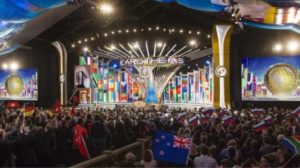Saint Hill. Photo credit: CSI
UNITED KINGDOM: The International Association of Scientologists’ 39th Anniversary and a protest that failed
One week before the three-day event attended by about 7000 Scientologists, opponents and the media announced a mass anti-Scientology demonstration. Only 46 showed up.
by Willy Fautré
Bitter Winter (28.11.2023) In early November, the International Association of Scientologists (IAS) celebrated its 39th anniversary in Saint Hill, East Grinstead (West Sussex), about 20 km from Gatwick airport. Three days were devoted to this event, which after four years of interruption due to the COVID was attended by about 7000 people coming from all continents, including representatives of different other religions such as Orthodox Christians, Hindus, Sikhs, Catholics, Jews, and Muslims.

39th anniversary of the International Association of Scientologists. Photo credit CSI
On the first day, they presented their humanitarian projects and achievements as well as the results of their campaigns in the last four years. Three winners of the IAS freedom medals were honored for their humanitarian campaigns in three specific sectors:
-A Mexican couple, Salomón and Lucy Dabbah, carrying out drug prevention campaigns all over the country in schools, countries, associations, law enforcement and government agencies;
-Yuzuro Ogura from Japan for exposing human rights abuses in psychiatric hospitals while achieving national laws to protect whistleblowers of such abuses;
-And a final one, Giselle Lima from Panama, promoting with the police and the government a non-religious moral code as described in their brochure “The Way to Happiness.” Moreover, she helped sanitizing other religious places of worship during the pandemic, gaining religious recognition in the country and forming the Religious Freedom RoundTable in Panama.
The second day was devoted to the Patrons’ Ball Dinner. During the ceremony, it was announced that there were thousands of individual donors from all continents who over the years had made donations ranging from USD 50,000 to USD 1 million and more. These were people who were successful in their professional life. More than 500 were present and were called to the stage by groups to be publicly thanked for their generosity. More than 1500 people attended the dinner followed by a concert and a ball.

Patrons’ Ball. Photo credit: JH
On the third day, the IAS along with the Church of Scientology /UK hosted a Saint Hill Gala Charity Concert attended by about 2000 people meant to finance several local projects unrelated to the Church.
A cheque of £ 50,000 was shared between several local institutions whose representatives detailed the projects to be implemented. The charities selected this year were:
-the East Grinstead & District Lions Club,
-the AGE UK East Grinstead, focusing on assistance to elderly people,
-the Queen Victoria Hospital Charity for reconstructive surgery or burns,
-the Friends of the Crowborough Hospital, and
-Access2Adventure, an entity helping people “get out of their comfort zone to grow resilience, confidence and self-esteem.”
The mayor, a local member of the British Parliament, and other local authorities were present. Among the artists participating in the concert:
- The Jive Aces, the UK’s No.1 Jive and Swing Band performing over 300 shows a year in over 40 countries;
- Mark Isham, an electronic music innovator, jazz artist and prolific film composer;
- Rodney Earl Clark, a celebrated baritone singer and West End star;
- Alberto Plaza, who performed over 1500 concerts in Latin America, earned multiple gold and platinum records;
- Chill E.B., a pro-survival rap artist, a jingle writer and screen actor;
- Michele Anderson, an international vocalist and Goodwill Ambassador to her native island of Dominica.
Tom Cruise was discreetly present during the three-day events.

Photo credit: THIX – Rapper Chill E.B.

Photo credit: JHHIX – Rapper Chill E.B.
The International Association of Scientologists
The International Association of Scientologists (IAS), a fundraising and membership organization run by the Church of Scientology, is an unincorporated membership organization open to all Scientologists from all countries. It is headquartered in England at Saint Hill Manor (East Grinstead, Sussex).
The IAS was created in 1984 by a number of delegates from Scientology Churches world over assembled at Saint Hill Manor (L. Ron Hubbard’s home from 1959 to 1966).
To confirm their dedication toward the aims of Scientology, those first IAS delegates formulated and signed The Pledge to Mankind.
The purpose of the IAS is: “To unite, advance, support and protect the Scientology religion and Scientologists in all parts of the world so as to achieve the Aims of Scientology as originated by L. Ron Hubbard.”
Lafayette Ron Hubbard (1911–1986) was an American prolific author of science fiction and fantasy novels in his early career. In 1950 he authored “Dianetics: The Modern Science of Mental Health,” “the Bible” or building cornerstone of his belief system and established organizations to promote and practice Dianetics techniques. During WW II, L. Ron Hubbard was an officer in the Navy where he briefly commanded two ships.
The IAS was formed in 1984 to protect the Church of Scientology and its members against intolerance, persecution and discrimination, as well as to guarantee religious freedom for all. However, in the last two decades it has been able to focus its resources on funding numerous humanitarian projects.
The Church of Scientology is a belief association which is active and legally practiced in more than 150 countries, being legally registered in over 100 of them. It is protected by Article 9 of the European Convention on Human Rights as it is confirmed by the jurisprudence of the European Court.
Few academic papers and books fairly cover the Church of Scientology but a recent paper by Donald Westbrook can be recommended for those who want to know more about this movement and its scholarly study and need a reliable compass: Scientology Studies 2.0: Lessons learned and paths forward.
Press coverage of the event under the magnifying glass
On 25 October, a huge anti-Scientology demonstration to be held by former disgruntled members was announced in “The Guardian” as “the biggest one since 2008 organized by members of the internet-based group Anonymous outside the church’s London HQ, which attracted more than 300 people.” It was then allegedly one of the ten most-read articles on that day, according to the anti-Scientology protestors who stressed that the newspaper’s website reached 110 million unique readers per month.
On the same day, “Newsweek” and “The Express” joined and amplified the same anti-Scientology campaign, also announcing the same “mass gathering” against the movement and/or their leaders, which never materialized.
The organizers also announced that the road to Saint Hill would be closed from 2pm until 10pm for their demonstration on 3 November but this never happened.
Moreover, there was no such big gathering: “46 protestors marched from East Grinstead and gathered at Scientology’s headquarters, making this the largest anti-Scientology’s protest since the Anonymous movement, 15 years ago,” according to the organizers themselves. Only 46 against the alleged over 300 demonstrators in 2008, which is seven times less… and they announced it as the biggest one for 15 years.
No such demonstration was ever visible or audible on the road to Saint Hill or near the entrance during the three-day event as the police kept them at distance.
None of these media outlets has afterwards reported on the failed demonstration in which less than 50 protestors participated but, in the meantime, they accepted to be their resonance box before their action and decided to keep silent afterwards about their spectacular flop.
Final score of “the match,” 7000 against 46, but that is not the message that public opinion received from biased media. It is not surprising that unfounded and unjustified hostility against some religious, spiritual and belief minorities persists in Europe. A number of European states are not paragons of religious tolerance and are not in a moral position to teach lessons to other countries. They should first look at themselves for some introspection and self-criticism, and even look at some far away countries on other continents that have better practices in this regard.
Further reading about FORB in the United Kingdom on HRWF website
